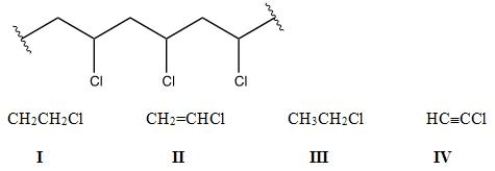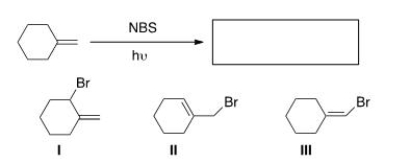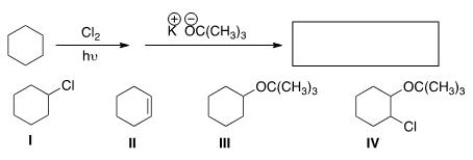A) Light or heat provides the energy needed for homolytic bond cleavage to form radicals.
B) Breaking the weak O-O bond of peroxides initiates radical reactions.
C) The diradical O2 removes radicals from a reaction mixture.
D) Radicals rearrange.
Correct Answer

verified
Correct Answer
verified
Multiple Choice
Identify the monomer used to make the following polymer. 
A) I
B) II
C) III
D) IV
Correct Answer

verified
Correct Answer
verified
Multiple Choice
How many products, including stereoisomers, are formed when 2-methylpent-2-ene is treated with HBr in presence of peroxides?
A) 1
B) 2
C) 3
D) 4
Correct Answer

verified
Correct Answer
verified
Multiple Choice
A possible reaction of ethane with chlorine is shown below.This reaction could conceivably occur by the following chain mechanisms [1], [2], and [3].Determine DH for step [2].Bond dissociation energies (kcal/mol) :
![<sup> </sup>A possible reaction of ethane with chlorine is shown below.This reaction could conceivably occur by the following chain mechanisms [1], [2], and [3].Determine DH for step [2].Bond dissociation energies (kcal/mol) : A) -5 kcal/mol B) +58 kcal/mol C) -28 kcal/mol D) None of the choices are correct.](https://d2lvgg3v3hfg70.cloudfront.net/TB5872/11eb4ad7_6c21_55fa_99b2_2f4993d51432_TB5872_00.jpg)
![<sup> </sup>A possible reaction of ethane with chlorine is shown below.This reaction could conceivably occur by the following chain mechanisms [1], [2], and [3].Determine DH for step [2].Bond dissociation energies (kcal/mol) : A) -5 kcal/mol B) +58 kcal/mol C) -28 kcal/mol D) None of the choices are correct.](https://d2lvgg3v3hfg70.cloudfront.net/TB5872/11eb4ad7_6c21_55fb_99b2_0b1c67345706_TB5872_00.jpg)
![<sup> </sup>A possible reaction of ethane with chlorine is shown below.This reaction could conceivably occur by the following chain mechanisms [1], [2], and [3].Determine DH for step [2].Bond dissociation energies (kcal/mol) : A) -5 kcal/mol B) +58 kcal/mol C) -28 kcal/mol D) None of the choices are correct.](https://d2lvgg3v3hfg70.cloudfront.net/TB5872/11eb4ad7_6c21_55fc_99b2_b13226f8d121_TB5872_00.jpg)
A) -5 kcal/mol
B) +58 kcal/mol
C) -28 kcal/mol
D) None of the choices are correct.
Correct Answer

verified
Correct Answer
verified
Multiple Choice
How many products, including stereoisomers, are formed when (R) -2,4-dimethylpent-2-ene is treated with HBr in presence of peroxides?
A) 1
B) 2
C) 3
D) 4
Correct Answer

verified
Correct Answer
verified
Multiple Choice
How many monochlorination products can be formed from the reaction of (CH3) 3CH with Cl2 and hn?
A) 1
B) 2
C) 3
D) 4
Correct Answer

verified
Correct Answer
verified
Multiple Choice
How many monochlorination products can be formed (constitutional isomers only) from the reaction of CH3CH2CH2CH2CH2CH3 with Cl2 and hn?
A) 3
B) 4
C) 5
D) 6
Correct Answer

verified
Correct Answer
verified
Multiple Choice
Determine the product(s) of the following reaction. 
A) Only I
B) Only II
C) Only III
D) Only I and II
Correct Answer

verified
Correct Answer
verified
Multiple Choice
Which of the following statements about the propagation steps in the chlorination of ethane is true?
A) Radical chlorination consists of two propagation steps.
B) The energy diagram for the propagation steps has three energy barriers.
C) The first of the propagation steps is rate-determining because its transition state is at lower energy.
D) The second of the propagation steps is rate-determining because its transition state is at higher energy.
Correct Answer

verified
Correct Answer
verified
Multiple Choice
Which of the following statements about carbon radicals is not true?
A) Carbon radicals are classified as primary, secondary, tertiary, or quaternary.
B) A carbon radical is sp2 hybridized.
C) The geometry of a carbon radical is trigonal planar.
D) The unhybridized p orbital in a carbon radical contains the unpaired electron.
Correct Answer

verified
Correct Answer
verified
Multiple Choice
A possible reaction of ethane with chlorine is shown below.This reaction could conceivably occur by the following chain mechanisms [1], [2], and [3].Determine DH for step [1]. ![<sup> </sup>A possible reaction of ethane with chlorine is shown below.This reaction could conceivably occur by the following chain mechanisms [1], [2], and [3].Determine DH for step [1]. Bond dissociation energies (kcal/mol) : A) -5 kcal/mol B) +58 kcal/mol C) -28 kcal/mol D) None of the choices are correct.](https://d2lvgg3v3hfg70.cloudfront.net/TB5872/11eb4ad7_6c21_2ee7_99b2_b937db53832c_TB5872_00.jpg)
![<sup> </sup>A possible reaction of ethane with chlorine is shown below.This reaction could conceivably occur by the following chain mechanisms [1], [2], and [3].Determine DH for step [1]. Bond dissociation energies (kcal/mol) : A) -5 kcal/mol B) +58 kcal/mol C) -28 kcal/mol D) None of the choices are correct.](https://d2lvgg3v3hfg70.cloudfront.net/TB5872/11eb4ad7_6c21_2ee8_99b2_91f86270d818_TB5872_00.jpg) Bond dissociation energies (kcal/mol) :
Bond dissociation energies (kcal/mol) :
![<sup> </sup>A possible reaction of ethane with chlorine is shown below.This reaction could conceivably occur by the following chain mechanisms [1], [2], and [3].Determine DH for step [1]. Bond dissociation energies (kcal/mol) : A) -5 kcal/mol B) +58 kcal/mol C) -28 kcal/mol D) None of the choices are correct.](https://d2lvgg3v3hfg70.cloudfront.net/TB5872/11eb4ad7_6c21_2ee9_99b2_e911be36ac36_TB5872_00.jpg)
A) -5 kcal/mol
B) +58 kcal/mol
C) -28 kcal/mol
D) None of the choices are correct.
Correct Answer

verified
Correct Answer
verified
Multiple Choice
Which steps are the rate-determining step in the mechanism of radical halogenation?
A) Initiation
B) Propagation
C) Termination
D) Initiation and Propagation
Correct Answer

verified
Correct Answer
verified
Multiple Choice
A possible reaction of ethane with chlorine is shown below.This reaction could conceivably occur by the following chain mechanisms [1], [2], and [3].The chain propagating step(s) is (are) _______. ![<sup> </sup>A possible reaction of ethane with chlorine is shown below.This reaction could conceivably occur by the following chain mechanisms [1], [2], and [3].The chain propagating step(s) is (are) _______. A) Only [1] and [2] B) Only [2] and [3] C) Only [1] and [3] D) Only [3]](https://d2lvgg3v3hfg70.cloudfront.net/TB5872/11eb4ad7_6c21_2ee5_99b2_653221a06289_TB5872_00.jpg)
![<sup> </sup>A possible reaction of ethane with chlorine is shown below.This reaction could conceivably occur by the following chain mechanisms [1], [2], and [3].The chain propagating step(s) is (are) _______. A) Only [1] and [2] B) Only [2] and [3] C) Only [1] and [3] D) Only [3]](https://d2lvgg3v3hfg70.cloudfront.net/TB5872/11eb4ad7_6c21_2ee6_99b2_69398e7b04d2_TB5872_00.jpg)
A) Only [1] and [2]
B) Only [2] and [3]
C) Only [1] and [3]
D) Only [3]
Correct Answer

verified
Correct Answer
verified
Multiple Choice
How many allylic halides can be formed when 3-methycyclohexene undergoes allylic halogenation with one equivalent of NBS and light?
A) 1
B) 2
C) 3
D) 4
Correct Answer

verified
Correct Answer
verified
Multiple Choice
How many monochlorination products, including stereoisomers, are formed from (S,S) -1,2-dimethylcyclopropane?

A) 4
B) 3
C) 6
D) 5
Correct Answer

verified
Correct Answer
verified
Multiple Choice
What is the product in the following sequence of reactions?

A) I
B) II
C) III
D) IV
Correct Answer

verified
Correct Answer
verified
Multiple Choice
How many monochlorination products (constitutional isomers and stereoisomers) are formed from the reaction of butane with Cl2 and hn?
A) 2
B) 3
C) 4
D) 5
Correct Answer

verified
Correct Answer
verified
Multiple Choice
Which of the following statements is (are) true about free radical halogenation of alkanes?
A) The first of the chain-propagating steps is rate-determining.
B) The reaction proceeds by way of a flat sp2 hybridized free radical.
C) The chain-initiating step involves cleavage of a carbon-hydrogen bond to afford a carbon radical and a hydrogen atom.
D) Statements (The first of the chain-propagating steps is rate-determining) and (The reaction proceeds by way of a flat sp2 hybridized free radical) are both true.
Correct Answer

verified
Correct Answer
verified
Multiple Choice
What is the product in the following sequence of reactions?

A) I
B) II
C) III
D) IV
Correct Answer

verified
Correct Answer
verified
Multiple Choice
Which of the following statements about radicals is true?
A) Cleavage of a stronger bond forms the more stable radical.
B) The stability of a radical increases as the number of alkyl groups bonded to the radical carbon decreases.
C) The higher the bond dissociation energy for a C-H bond, the more stable the resulting carbon radical.
D) Less stable radicals generally do not rearrange to more stable radicals.
Correct Answer

verified
Correct Answer
verified
Showing 21 - 40 of 42
Related Exams